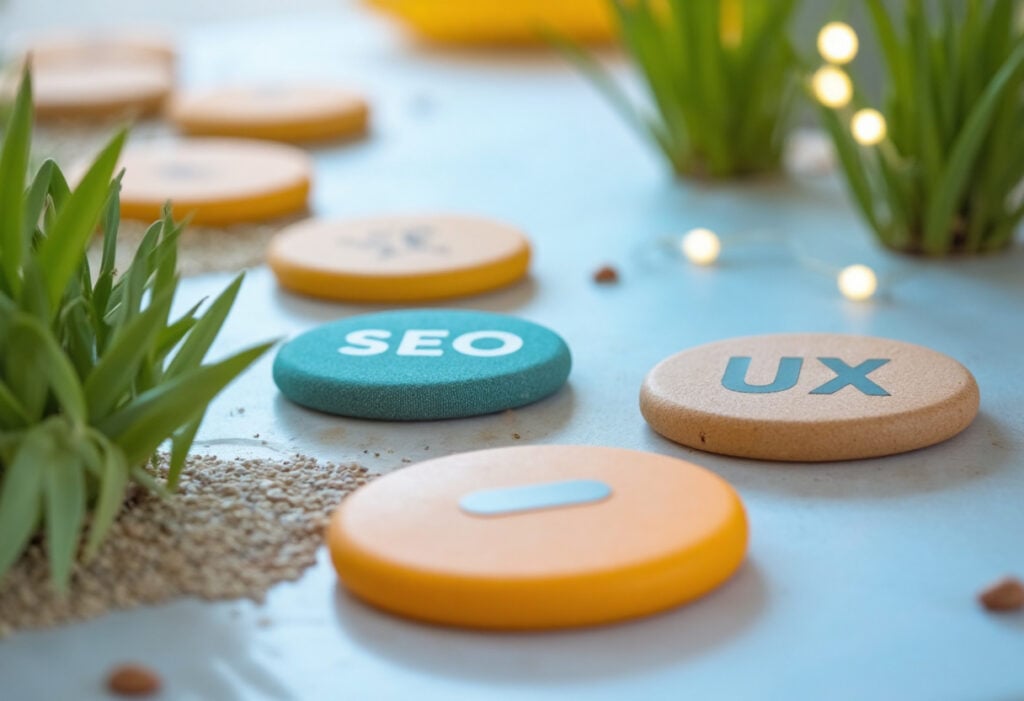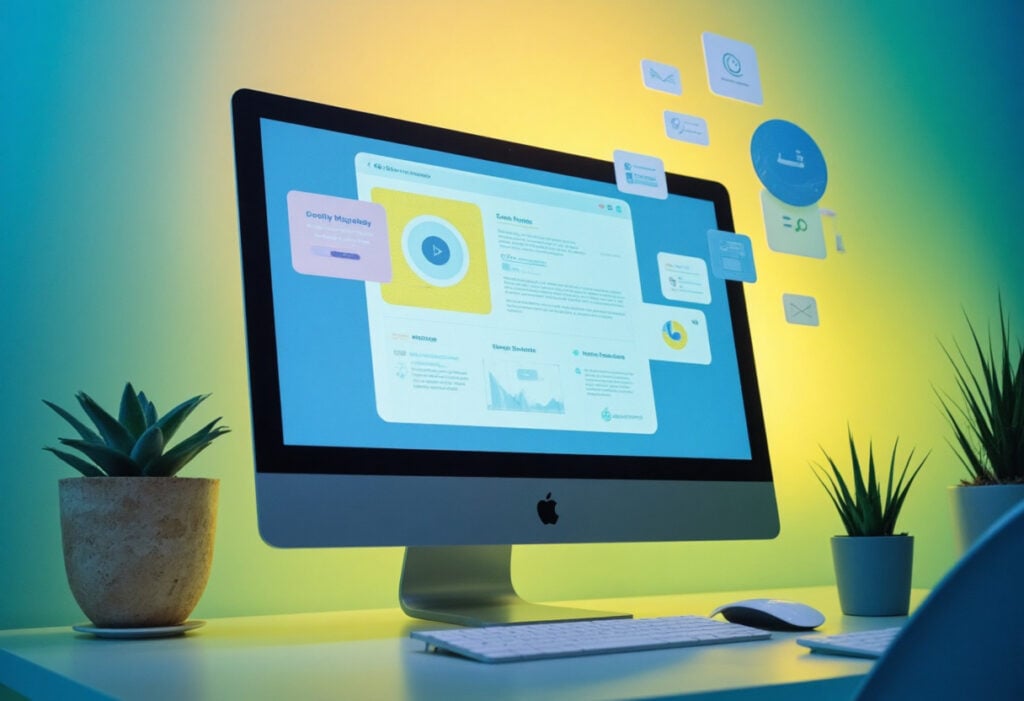Starting to build your business website can feel overwhelming, especially if you’re unsure where to start. In this article we explore the elements to consider when designing and building a business website.
Read on for a step-by-step guide to building your website, tips on things to consider after publishing your website, answers to commonly asked questions and more!
1. Define the purpose and goals of your website
The first step in building your website is to determine the purpose and goals of your website. Will your website’s purpose be sales, lead generation, to entertain, to provide information, to entertain or to facilitate communication?
When defining your business goals, it can be useful to implement a ‘SMART’ approach, by creating goals that are Specific, Measurable, Achievable, Relevant and Time-Bound. Consider the user actions you’d like visitors on your website to take to help you define the goals.
All other decisions you take should flow from the purpose and goals.
2. Choose a domain name
Choose a domain name that’s simple to type and easy to remember. Avoid using underscores, which are not recommended by Google.
Choose a domain name closely related to your business. However, often it’s a good idea not to choose a domain name that’s too limited to one particular product, in case you decide to expand your products or services in future.
Typically it’s a good idea to select a domain name that ends in .com, .co.uk or .org. Consider buying the variations of the domain name if it’s important to you to retain ownership across markets.
You can check the availability of and buy domain names using various services like GoDaddy, 123Reg, Easy Space and more. However, you may wish to buy a domain name from your chosen hosting provider, so check out step 3. before purchasing!
3. Register your domain name and choose a hosting provider
The next step is to purchase the domain name and select a hosting provider. Many web hosting providers provide the domain name for free! Check on these services to see if they offer WHOIS privacy, if that’s important to you.
Popular hosting options include WordPress, Wiz and Squarespace.
Check what types of hosting are available, what each package offers, including support, and how much each option costs. Your choice of hosting provider can be determined by your business website’s requirements.
Can you register a domain with one company and host with another?
It is possible to register a domain with one company and host it with another. It is also possible to transfer a domain to an alternative hosting provider.
4. Choose a website builder or select an agency
The next step is to choose a website builder, or select an agency.
Often a website builder, such as WordPress will be available with the hosting solution. Wix and Squarespace both offer website builders too.
Alternatively, you could request the help of a web design agency. This doesn’t have to be too costly, you may be pleasantly surprised by the pricing if you get in touch!
5. Map out your website
The next step is to map out your website. Consider the pages you’d like to have, and their priority level. Create a sitemap including the pages you’d like to have on your website, and how they interact with each other.
Make sure to keep your navigation quite simple to begin with, you can always add more pages if needed at a later time.
Simple navigation minimises distractions for users, making it easier for them to find the information they need.
Pages to include within your website include:
- Homepage
- Product or Services Page(s)
- FAQs
- Contact Us
- About Us
- Testimonials
- Pricing
- Newsletter sign up
Consider the user journey throughout the website, and the action you’d like users to take. Think about how the navigation can help support that journey by placing the most important information as a priority in the navigation.

6. Start designing page templates and wireframes
Consider the layout of the pages of your website. Is there a template you could use on pages of the same style to give your website a consistent look?
Consider creating wireframes for different page types. Place the most important information above the fold, so users can see it straight away whether they’re on desktop or mobile.
When creating wireframes, think about using whitespace, images and the right amount of copy to get your message across. Avoid creating a page that’s too cluttered, to ensure your website’s message stays strong and clear. For more information on web design principles, check out our guide to minimal web design.
7. Think about a web design that encapsulates your brand
The next step is to consider the design elements of your website.
At this stage of the process, it’s useful to lock in things like:
- Typography
- Logos
- Colour schemes
- Images
- Written content style
Typography
When considering typography, choose a font that’s above all easy to read. Consider the purpose of your brand and website, and try to find a font that helps to cement your brand’s message. Use of font can really help to form the user’s first impression of your brand, so it’s important to give this careful consideration. Consider if you’d like to use a ‘primary’ font and also a ‘secondary’ font to help add variation into your website text and highlight content priorities. Make sure the two fonts complement each other visually as well.
When selecting a font and font size, consult the latest readability and accessibility guidelines, to ensure your website’s content is accessible for all website visitors.
Logos
Logos are a key component of the design of your website. Think about how you’d like your logo to appear on your website, and where on pages you’d like the logo to sit. Consider how you’d like your business to appear on search engine results pages too.
Colour schemes
Consider the colour scheme of your site, how that works with your logo and how your colour scheme will impact the images you choose. Select a colour scheme that’s memorable, but also cohesive. A primary colour paired with accent colours can help to add some variation and support your brand message. Think about how the colours you choose will strengthen your brand image and help your business stand out.
Consider the use of contrasting colours and the impact on readability to ensure all website visitors can easily read your website content.
Images
Consider what kind of images you’d like to use on your site, where you will source these from and how they will work in your layout to add visual interest. Ensure any images you use are high quality to provide the best impression to website visitors of your brand.
You can use tools like Unsplash or Pixabay if you’re on a budget to source images to use on your site. But, be careful to check the licence requirements.
Tone of voice
Consider how you’d like your business and brand to sound. Will your website copy be warm, welcoming and inviting, or does your business suit a more direct tone?
Your business’ tone of voice will be heavily influenced by the products or services you’re offering. Some products will suit a more casual, humorous tone, whereas others will require an informative, no-nonsense approach.
8. Build pages
The next step in the design process is to build out your pages!
Options for building out your pages include:
Visual Website Builders
Popular Visual Website Builders include WordPress, Wix, Squarespace and HubSpot Website Builder.
WordPress
WordPress offers thousands of plugins to help you customise the look, feel and functionality of your site. It offers a choice of page builder plugins which offer drag-and-drop design capabilities.
WordPress can be used to create a variety of web pages including e-commerce platforms, blog posts and more. It offers a user-friendly editor so you can edit webpages without requiring technical knowledge. It does however also offer the option to edit using HTML, providing greater customisability for your website’s content. You also have the option to customise the entire site using a visual block-based interface. WordPress offers the option to edit themes for advanced customisation, is SEO-friendly and offers responsive design. There’s even more we could say about the features WordPress offers – it’s our top recommendation if you’re looking for a webpage builder!
Wix
Wix offers customisable templates, a drag-and-drop interface, e-commerce functionality and built-in tools for tracking website performance. It also offers free hosting with Wix branding.
Squarespace
Squarespace offers professionally designed templates, the ability to duplicate pages to speed up site building, and inventory management and abandoned cart recovery for online stores.
HubSpot Website Builder
The HubSpot Website Builder offers drag-and-drop editing, pre-built themes and templates, as well as pre-built features like forms and CTAs. HubSpot Website Builder also offers free hosting and an SSL certificate.
Code Editors
Another option for building out your web pages is Code Editors.
If you’re comfortable with coding, the following options may work for you:
Adobe Dreamweaver
Adobe Dreamweaver enables you to build responsive websites from scratch, or you can use templates. It includes code hints, GitHub support, integrations with other Adobe tools like Photoshop, as well as tools for building HTML emails and e-commerce sites.
Visual Studio Code
Visual Studio Code is another option, which works with Windows. This free code editor offers features like syntax highlighting, code completion, integrated terminal and debugging tools and a large extension marketplace.
Design and Prototyping Tools
Canva
Canva, primarily a graphic design tool, now offers web design capabilities so you can create a professional looking website with ease. This tool offers customisable web-page templates, free stock images, graphics and a drag-and-drop editor.
Figma
Figma is a popular collaborative design tool that’s useful for prototyping. It offers real-time collaboration features, design system tools and interactive prototyping.
9. Add engaging user-focused content
The next step in building a website is adding engaging user-focused content. Ensure to add the main things users would expect to see, and avoid cluttering your website with unnecessary information.
10. Implement an SEO (Search Engine Optimisation) strategy
Prior to creating your user-focused content, we’d recommend doing some keyword research using tools like Google Keyword Planner, Ahrefs or Semrush. This can help you identify common questions your users may have. Optimise your website for search by targeting keywords, however be careful to avoid keyword stuffing. Check your content has a meta title, meta description and appropriate header tags within the content such as an H1, H2s and H3s if necessary. Optimise your URLs to be short, readable and include target keywords. You can also optimise for search by ensuring images are in the correct format to improve page loading times. Ensure your website has a responsive design that works well on mobile devices. The most important thing is making sure content is user-focused.
Make sure you’ve set up Google Analytics and Google Search Console which will help you track your website’s performance and identify opportunities for future optimisation.
11. Add relevant forms
The next stage is to add relevant forms to your site. We’ve created a whole guide to landing page optimisation, check it out to find out more.
12. Connect the payment processor
If you’re selling products on your site, the next step is to connect the payment processor, and check it’s working correctly. Popular payment gateway options include Stripe or PayPal. If you’re using WordPress, you have the option to use a plugin such as WooCommerce which supports Stripe, PayPal, Square, Apple Pay and more.
Ensure to test your payment gateway using Test Mode in the payment gateway settings if available.
13. Review and test your site
The final step is to review and test your website. Conduct a content and design check, functionality test and well as a technical review, SEO and analytics checks to make sure everything is set up correctly and is displaying as expected.
You should now be on the road to building a successful website! But what happens after your site is live?
14. Update your site regularly
Regular maintenance of your website is important to ensure it performs at the optimal level. Find out more in our guide to maintaining your WordPress website.
Steps to take after your website is published to further drive performance:
Some steps you can take to further drive performance after your website is live include:
- Add customer testimonials and reviews to build trust in your brand.
- Add new products and services.
- Consider creating a blog, which can help to improve your website visibility in search engines.
- Monitor data analytics regularly to identify any potential problems and make optimisations.
- Consider A/B testing landing pages to make improvements.
- Maintain your website, which is crucial for security, performance, and user experience.
Top tips for designing and building a business website
Here’s a summary of our top tips for designing and building your business website:
- Budget effectively: Creating a clear timeline at the outset of the project can help to manage this.
- Focus on user experience: A website will only be successful if it serves the user’s needs effectively. Ensure to prioritise the user-experience in any decisions you make.
- Optimise landing pages through A/B testing: A/B testing is a useful tool to understand which layouts, CTAs or features are most successful on your site. Consider using A/B testing to guide your decisions on optimising your pages.
- Consider analytics: Regularly review your website’s analytics to identify any issues, and areas of success.
- Prioritise mobile responsiveness: Websites that are mobile responsive are preferred by search engines such as Google and tend to be served higher in search results, known as mobile-first indexing. Making your site mobile responsive can also help to enhance the user experience.
- Prioritise website speed: Website speed is important not only for SEO, but also for the user-experience. Bounce rates tend to be lower on faster websites, so making sure your site loads as quickly as possible is crucial.
- Consider SEO: SEO is important to boost your online search visibility and help more users find your site.
- Implement easy navigation: Implement clear navigation to help users easily find the information they need and guide them toward the desired action without disrupting their journey.
- Place the most important information above the fold: Place the priority information, such as a CTA or contact information above the fold on your webpages, to ensure these are clearly viewable by users on mobile and desktop devices.
- Make security a priority: Ensure your site is secure and regularly update your website to protect against security vulnerabilities.
- Connect your marketing efforts: Connect your marketing efforts across social media platforms and email marketing campaigns to drive users to the site.
- Test across devices: Test your website across devices to ensure it displays as expected.
The benefits of creating a business website
You may question whether you even need a business website; perhaps your business is performing well by word of mouth, or you prefer to use social media to promote your services.
Although these are both great tools, having a business website is undoubtedly a fantastic way to cement your business reputation, and build trust in your brand. Through search engine optimisation, you can also attract more visitors to your website to let more people know about your services.
The key benefits of having a business website include:
- Generating leads.
- Can be more cost-effective than other advertising methods.
- Enhances brand trust and authority.
- Improves customer service through FAQs, contact forms, product descriptions, etc.
- Offers long-term value as once a well-built website is created, it can generate leads over time.
Building a website FAQs
Yes. A business website can be a good tool to build brand authority, trust and help generate more leads in a cost-effective way.
Key features a business website should have include information on products or services, FAQs and Contact Us pages.
The cost for building a website can vary depending on your business’ requirements. At Yellowball, we offer bespoke website creation, as well as Yellowball Lite, a templated website option.
Our bespoke websites tend to take 12-16 weeks to create. Templated websites can usually be created within 4-6 weeks depending on your business’ requirements.
Partner with Yellowball
Yellowball is a multi-award-winning web design agency in London. We work with businesses large and small, creating bespoke websites that shine online. Let our team show you what your online presence can do. Contact us today.
Read more: Small Business Website Guide, How to Build a Website from Scratch and What Makes a Good Website Design?










